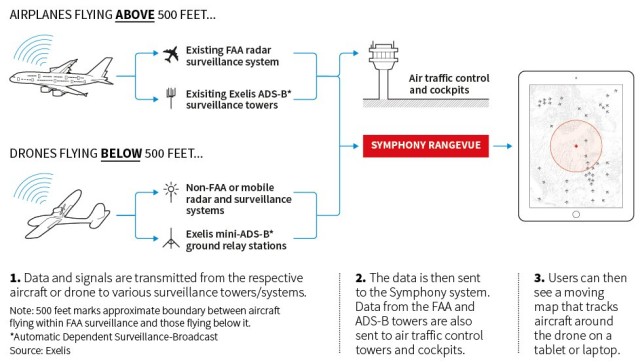U.S. aerospace company Exelis Inc. is close to unveiling a low-altitude surveillance system for drones, the latest sign of how a “highway in the sky” is likely to evolve.
The system, whose existence has not been previously reported, shows how Exelis and other companies are racing to create technology that enables drones to safely fly over long distances to do everything from inspections of remote pipelines to surveys of crops or delivery of packages.
The U.S. Federal Aviation Administration recently proposed regulations that largely ban unmanned aircraft systems from many of those tasks by requiring that remote pilots keep the drones in sight. This is giving foreign companies the chance to leap ahead of the U.S. in figuring out how to best exploit drone technology.
But the National Aeronautics and Space Administration (NASA) is working with Exelis and other companies, universities and government agencies, to develop an air traffic management system that could persuade the FAA to allow flights beyond the line of sight, provided the operator is using such a tracking system.
Exelis’ products, called Symphony UAS-Vue and RangeVue, are significant because Exelis has a head start on competitors: It has the exclusive right to use a data feed it already supplies the FAA to track manned aircraft, using 650 ground stations. It will augment the feed with lower-altitude data that pinpoint drone locations, says Exelis, which is being taken over by communications company Harris Corp in a $4.75 billion deal.
“For any drone that needs to go beyond line of sight, this is a potential solution,” Edward Sayadian, vice president of civil aerospace systems at Exelis, told Reuters.
Exelis said it plans to announce the products this month and make RangeVue available this summer at some of the six sites the FAA has set up to test drones. The company developed the system quickly in the last six months, and hasn’t yet set prices.
While Exelis sees potential markets overseas, it is focused initially on the U.S., where it can leverage its ground stations and FAA feed. It also wants to be part of whatever overall system the FAA adopts after NASA finishes work on the prototype in three to five years.
In the meantime, Exelis said it plans to market its UAS-Vue and RangeVue directly to companies that want to operate drones commercially in the U.S.
MOVING MAP
Exelis’ drone tracker will show terrain, weather and airspace boundaries in real time. The system can be called up on tablets and laptops, and can send emails and text message alerts if a drone is in a danger area.
“It’s like the moving map that you have on the GPS in your car,” Exelis’ Sayadian said.
Exelis also is creating portable relay stations that can be set up in the field to extend the range a drone can fly away from the pilot. It plans to test them on the trans-Alaska oil pipeline this year.
Though NASA is working with Exelis, it said other communications companies also could provide drone tracking in the final system. The system that is ultimately adopted could be operated and maintained by federal, state or local governments – or by private companies using a fee for service model, NASA says.
A spokeswoman for the FAA, which will chose the final configuration, said it is too early to discuss what the system might look like.
Source: Reuters

